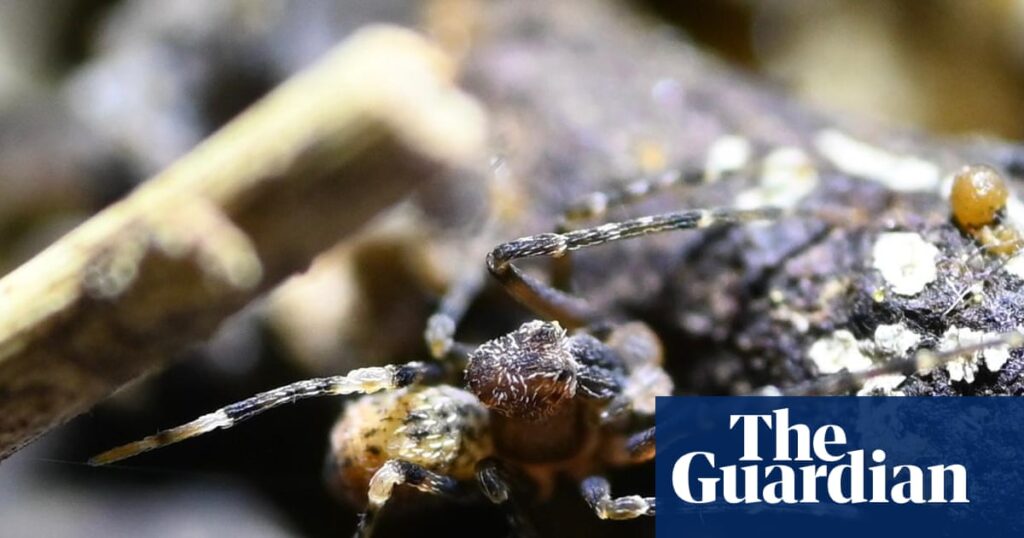For the last five weeks, Jane Ogilvie has searched a patch of dense shrub shaded by sugar gums on Kangaroo Island in South Australia for a surviving relic from 150m years ago.
The only known home of the critically endangered Kangaroo Island assassin spider is in the north-west of the island, where the Jurassic-era spider hides out in moist clumps of leaf litter.
In more than a month of searches, and with just a couple more weeks to go, Ogilvie and a few helpers have only found one tiny juvenile.
“We get so excited when we find a good area but then it’s deflating. Everything is so dry – it’s hardly rained for two years,” says Ogilvie, a conservation biologist working with the charity Invertebrates Australia.
Last year, scientists found just one mature female and six juveniles at six locations, all in a 20 sq km area that includes a block of land owned by mining billionaire Andrew Forrest.
Those same locations have come up blank this year. The spiders need the moist microclimate of the leaf litter to survive, but there’s a trifecta of threats drying out their habitat and pushing them ever closer to extinction.
The spider’s last remaining bolthole has been through near-record drought over the last 18 months, with rainfall among the lowest on record since 1900.
The black summer bushfires burned through large areas of potential habitat that have not yet recovered, and an invasive plant root disease known as phytophthora is damaging the forest canopy and the plants that hold some of the leaf litter where the spiders live, drying out the habitat even further.
“If we look at the risks and [are] realistic, they’re potentially one big fire away from extinction,” says Dr Michael Rix, the principal scientist and curator of arachnology at the Queensland Museum, who collected the first specimens of the spider and, with scientific colleague Mark Harvey, formally described them.
“By all objective measures, its existence is phenomenally precarious.”
Natural-born assassins
The Kangaroo Island assassin spider is one of 11 invertebrates on the federal government’s priority list of threatened species.
The assassin family of spiders – which get their name from their habit of slowly stalking and then eating other spiders – are found only in Australia, Madagascar and parts of southern Africa.
Kangaroo Island’s assassin was found in 2010 by Rix, who, along with Harvey, has described 37 of Australia’s 41 assassin spiders.
“We collect this suspended leaf litter and shake it. The spiders close their legs and they drop down. I looked in the tray to see what’s there – I knew it was undescribed. It was one of the really memorable moments of my field biology career. Very exciting,” he remembers.
Rix says they have the most unusual appearance of any spider, with “incredible elevated heads and long spear-like mouth parts”.
“They’re unmistakeable,” he says. “They’re an early branch in the spider’s tree of life. Assassin spiders are ancient and those around today are survivors of 150m years of life on Earth.
“They were only known as fossils before any living ones were found in Madagascar in the 19th century.”
after newsletter promotion
‘It’s being squeezed’
Kangaroo Island’s species was feared extinct after bushfires swept across the west of the island in the black summer bushfires of 2019 and 2020 until Dr Jess Marsh, a research fellow at the University of Adelaide and an invertebrate conservation biologist based on the island, found two specimens in 2021 in a small patch of unburned vegetation.
“It’s being squeezed into smaller and smaller areas,” says Marsh. “Each survey we do is increasing our confidence that its restricted to this patch of vegetation, and nowhere else.”
Marsh and colleagues are now discussing the idea of establishing a breeding program for the spiders in a zoo, creating an “insurance population” – but removing individuals from the wild carries clear risks that Marsh says wouldn’t be taken lightly.
“They’ve survived mass extinction events and past climate changes – a huge amount. Now in this short period of time, it’s humans that are really testing them.”
Ghost extinctions
Rix says the precarious situation the spiders find themselves in is part of a much bigger wave of largely unseen extinctions of invertebrates.
Officially, Australia lists only one invertebrate as extinct – the Lake Pedder earthworm.
But last year, Rix, Marsh and colleagues released research that estimated that since the European invasion of Australia, about 9,000 invertebrates had likely suffered a so-called ghost extinction – “the loss of undiscovered species that have left no trace.”
“Some people might say, ‘who cares about a tiny spider going extinct’?” says Rix. “But this is part of the quantum of invertebrate extinctions that we’re experiencing right now. This might be a problem that creeps up on us.
“There’s a concept of conserving evolutionary significant units – retaining diversity that speaks deeply to Earth’s evolutionary history. That is what these spiders are – a window into the past. They’re survivors. Trying to conserve them is so important.”
Marsh and Rix were the only two people to have ever found a Kangaroo Island assassin spider, until this week’s discovery – not by a scientist, but an enthusiastic 17-year-old volunteer called Jack Wilson who was filling his time during school holidays.
“It was probably my 10th sieve of the day,” he says.
“They can look like little blobs of dirt, but it’s the big neck that gives them away. I’m pretty chuffed. It’s crazy.”


